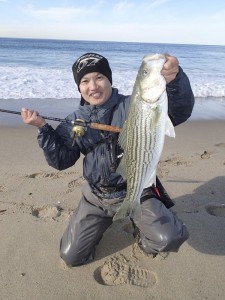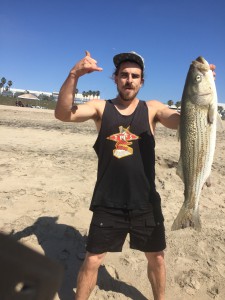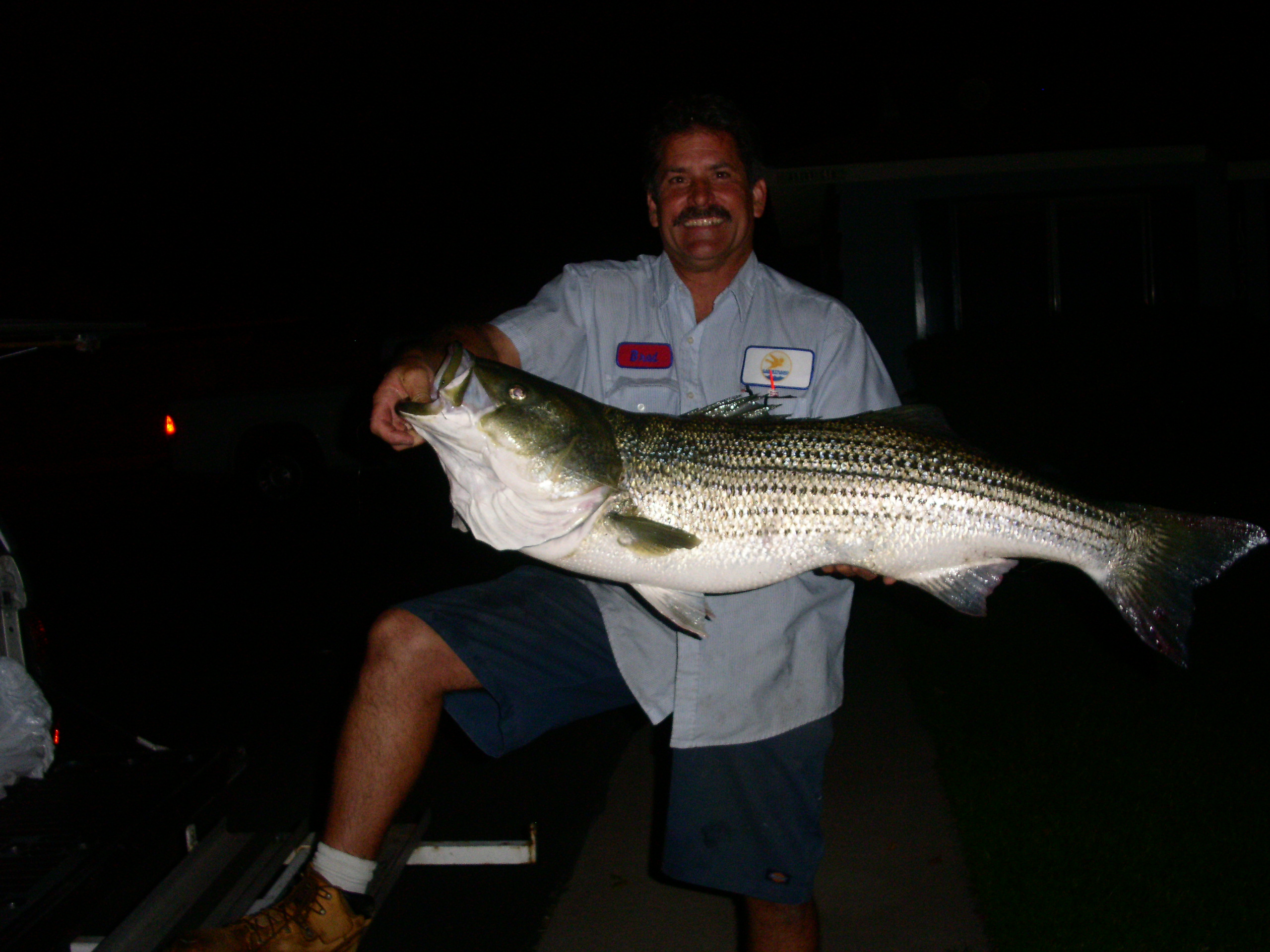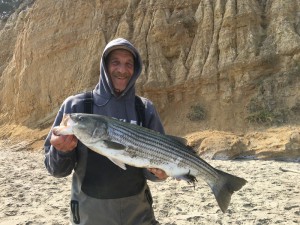Striped Bass Fishing in Estuaries, Bays and Along the Beach
By Bill Varney Jr.
Over the last few decades there were so few stripers caught in the Southern California surf that catching one was almost considered a miracle. Yet, over the past several years stripped bass catches have increased dramatically for anglers fishing estuaries, back bays and all along the beach.
Surprisingly, these fish have been caught up and down the coast rather than being relegated to one particular area. The most notable catch in the past two years was a fish taken by Brad Baier in Newport beach just two summers ago. Loaded with six pound test and a short strip of squid Brad landed a 40lb striper from the rocks in Newport Beach in the middle of the night.
Just last week another beautiful fish was taken along Dockweiler State Beach by Colin Rhodes who was also using a strip of squid that he had just launched into the surf. It was about 3pm when Colin cast out into the surf. As soon as his bait hit the bottom the fight was on. After a couple great runs Colin brought the fish to the sand to the amazement of everyone around him. These are just two of the dozens of reports I have received in just the last five years of striped bass catches.
I’ll admit that I’m jealous. So to raise my chances of catching one from the beach (and striking it off my bucket list) I sat down with Cousins rod designer and professional guide Greg Silks to learn how to target this prized fish in the surf.
Striped bass are found in both fresh and salt water. Besides being found inland, they can be caught along the West Coast in bays, estuaries and along the open beach. Striper range from one to one-hundred pounds. They often run up and down rivers and transit the coast looking for food. Predatory by nature, they are always on the prowl for an opportunity to feed.
Transiting fish can travel as much as thirty miles per day in search of food and shelter. From 1978 through 1980 Calfiornia Fish and Game stocked thousands of striped bass in Newport, Huntington and Long Beach harbors in hopes of introducing a new game fish to local anglers.
To take advantage of this great fighting game fish I sat down with Greg and asked him a few questions about how to get started.
What rod and reel combinations do you recommend for striper fishing?
“Always match the size of your rod and reel to the size of striper you are fishing for. A good starting point is to use a seven to nine foot medium action rod matched to a four-thousand series spinning reel. If you are fishing with live bait spool up with 6-12lb mono.
If you are fishing lures upsize your line to 20-30lb mono or a combination of braid with a mono top shot. Lure fishing also allows you to use either a spinning outfit or a conventional outfit depending our what you like to use most. You may want to downsize your equipment for fish under ten pounds and up size for those in the fifty plus range.” Greg prefers monofilament to braided lines because of their stretch and their ability to be easily broken when snagged.
 What rigging setup do you use for striper?
What rigging setup do you use for striper?
“Rigging depends on the size of fish and where you are fishing. For live bait fishing I like to use the Carolina Rig. In light current areas I may use a short as a six inch leader and as long as three feet in spots with ripping current. My sliding sinker will range from ½ ounce to three ounces depending on current and area I am fishing. When fishing light current I recommend a light sinker and employ a heavier sinker when the current is strong. For hooks I like to use the Gamakatsu Octopus hook in sizes 1 to 2/0.
When fishing lures for striper I will tie a 110lb crosslock snap swivel to my main line and clip the lure to it. This rig makes it easy and quick to change lures. Both of these setups work well in both fresh and saltwater applications.
What kind of bait do you like to use for striper in the surf?
“Both artificial lures and live/fresh dead bait work well for striper. Some of the traditional lures used over the years have been krocodiles, kastmasters, Rapalla minnows and recently Lucky Craft Flash Minnows. I have developed a line of striper lures which you may view on my site: Zpluglures.com. These lures are from six inches to twelve inches long and offer both straight one piece and broken back models.
When it comes to live and fresh/dead baits you have a number of options. Squid, mackerel, anchovy, sardine, chunk baits, blood and lug worms, crawdads, sidewinder rock crabs all work great for bait. Look for the forage that occurs naturally in the place you are fishing and use that—it’s probably what the fish are eating!
Ok, now for my most important question: Where do you find striper and have the best shot at catching one in the surf?
“As you know, stripers have been caught all along the coast, outside harbors and estuary entrances. These fish are varacious eaters and spend all their time looking for food. Striper can transit up to thirty miles per day looking for areas to forage. Once they find a bait source they may stay there for hours or days.
 One sure fire way to find them is to look for diving, feeding birds working areas of bait just offshore. In cases like these I like to use a long rod and cast a lure into the frenzy. Many times striper, in combination with other fish, will be pushing the bait up to the surface. Because striper run in schools, if you find one you can be well assured others accompany them.
One sure fire way to find them is to look for diving, feeding birds working areas of bait just offshore. In cases like these I like to use a long rod and cast a lure into the frenzy. Many times striper, in combination with other fish, will be pushing the bait up to the surface. Because striper run in schools, if you find one you can be well assured others accompany them.
Another great area to find striper is near harbor and estuary entrances and near the end of jetties. Fish these areas two hours before and after the high tide when large amounts of water are creating eddies where structure meets sand.
Without question the best time to fish for striper may be after dark. Nighttime offers some cover for these fish and allows them to approach and forage on prey. I like to fish them in any low light situation (sunrise, sunset and at night) and find that a high tide around 8pm is ideal for both low light and no light opportunities.
During the day areas that provide shade and a “light-break” over water are also good places to target. Look for docks, bridges, overpasses and other structure which provides shade. The right conditions here would include a combination of current and shade that set up a break or “wall”. This is where fish will congregate.
Good stuff! What tips would you have for anglers looking to catch a striped bass in the surf?
“ My first tip: Be patient, look for the conditions we discussed above, learn the habits of these fish and pay attention to tide, light, bait and rigging once you begin to catch fish.
Once you hook a striper always keep you line tight to the fish. Stripers have an uncanny ability to spit the hook–so any slack is your enemy–and will often allow the fish to disengage. Accordingly, keep your line tight to the fish and fight it paying special attention to keeping the fish straight out in front of you.
Once you catch a striper remember to grip it by the tail and lift it from under the body. Striper gill plates are very sharp and the larger fish will easily cut your fingers.
Last tip: Striped bass are breeders and produce as many as 10,000 eggs per spawn. They grow and reproduce quickly so go ahead and keep one—they make excellent table fare!
To learn more about striper fishing and Greg’s lures, rods and guide service visit his site: inlandguideservice.com or give Greg a call at (951) 443-6130.

